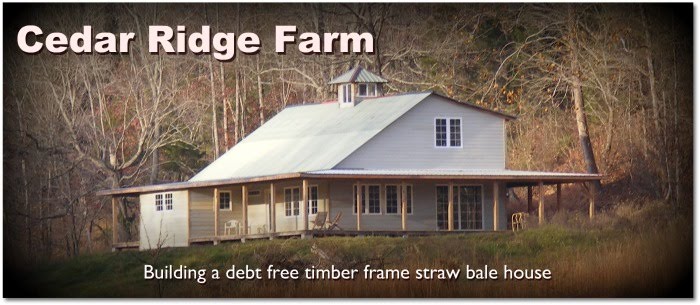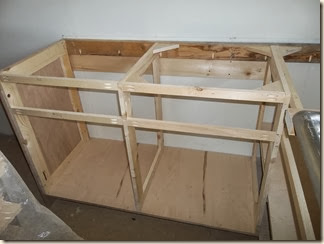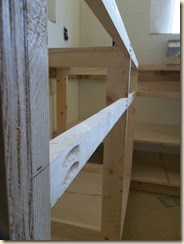I’ll refrain from offering excuses for my lack of blogging during the last however many months.
Last week I began to work on the specific design of the kitchen cabinets for the house. The kitchen space is not large and doesn’t allow for standard kitchen cabinet dimensions/design, especially when factoring in the double-basin commercial sink we purchased. I also didn’t want to pay for commercially-made or specialty-made cabinets (at least not pay someone else – my neighbor says I’m cheap, but I prefer to be called frugal).
The design phase (which actually overlaps quite a bit with the construction phase, at least when I’m the one doing it) began with the dimensions of the kitchen and the locations of the windows and door. We opted for large windows in the kitchen for the light which affect upper cabinet location and size. Lower cabinets have to fit in a space delineated by the refrigerator location and the door to the summer kitchen/porch. We will have no stove in the kitchen since we cook on the wood stove we heat with (or do we heat with the stove we cook on?) during the winter and outside in the summer kitchen during the summer. The basic setup is a U-shape with a short leg on the right and the sink in the middle under the 6-foot window (which is on the longest wall straight ahead as you go into the kitchen).
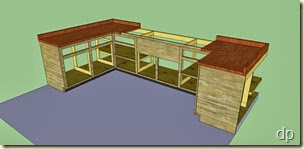 I searched the internet for information on built-in kitchen cabinets and didn’t find much. So, I made my own plans. I spent some time with Google Sketchup in order to explore my ideas about how to make them. Then, I began the actual construction.
I searched the internet for information on built-in kitchen cabinets and didn’t find much. So, I made my own plans. I spent some time with Google Sketchup in order to explore my ideas about how to make them. Then, I began the actual construction.
 My construction method involves using 2x4’s to frame the toe kick (with some 3/4” plywood to raise it the level of the finished floor). I also put a 2x4 along the wall at the height of the bottom edge of the counter top. I will use some 1-1/2” cherry to construct the counter top. Then, I used maple-veneer plywood for the bottoms of the cabinets and for shelves. I used my Kreg jig to construct some internal rectangular frames using 1x’s I ripped to the desired width and cut to length. Throughout this process, I continuously checked that things were plumb and level.
My construction method involves using 2x4’s to frame the toe kick (with some 3/4” plywood to raise it the level of the finished floor). I also put a 2x4 along the wall at the height of the bottom edge of the counter top. I will use some 1-1/2” cherry to construct the counter top. Then, I used maple-veneer plywood for the bottoms of the cabinets and for shelves. I used my Kreg jig to construct some internal rectangular frames using 1x’s I ripped to the desired width and cut to length. Throughout this process, I continuously checked that things were plumb and level.
I secured the rectangular frames into position with pocket screws (Kreg jig, again) and connected them to one another to frame the openings for drawers and cabinets. Later, I will construct face frames for the cabinets using 1x oak boards, and then I will make the doors and drawers.
The design of the kitchen includes five drawers with cabinet space below them. We’ll have eight pull-out trays to better utilize the cabinet space. There was not a good way to make the space in the corners of the U easily accessible. The space can be used, just not very well.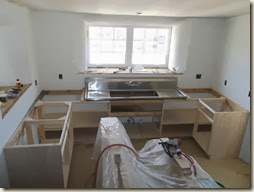
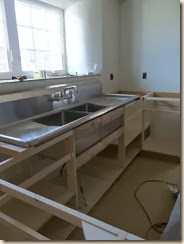
At this point, I have most of the rough framing done for the lower cabinets. I will continue with them and then move on to the upper cabinets. They will also employ some custom design, but more on that at a later time.
